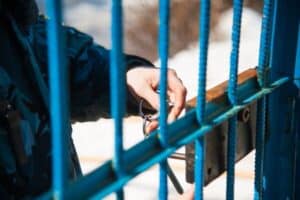Corrections Canada Situational Judgement Practice
- Posted by Brian Stocker
- Date May 30, 2023
- Comments 2 comments
Corrections Situational Practice Questions
Themes and Scenarios
The Corrections Officer situational judgement questions are designed to assess your judgment and problem-solving ability by presenting work-related scenarios in the Correctional Service of Canada (CSC).
The scenarios cover the following themes:
- Response to fire, environmental hazards and medical emergencies
- Security of the institution and the public
- Enhance offender accountability
- Security of inmates, including during transport

Canada Corrections Course
Canada Corrections Practice
Corrections Situational Judgement Practice Questions
Scenario 1: Inmate Agitation during Transport
Situation: While transporting inmates, you encounter an agitated inmate who starts banging on the vehicle’s doors and threatening the staff.
Question 1: How should you handle this situation?
A) Ignore the inmate’s behavior and continue driving.
B) Immediately stop the vehicle and address the inmate’s concerns.
C) Call for backup and request assistance from nearby law enforcement.
D) Engage in a physical confrontation with the inmate.
Q1. The most effective response to this situation would be:
A B C D
Q2. The least effective response to this situation would be:
A B C D
Scenario 2: Medical Emergency during Transport
Situation: While transporting an inmate, you notice the individual experiencing a medical emergency, such as difficulty breathing and chest pain.
Question: What should be your immediate response in this situation?
A) Continue transporting the inmate and inform medical staff upon arrival.
B) Administer first aid to the inmate using available supplies.
C) Immediately call for emergency medical services (EMS).
D) Delay seeking medical assistance until reaching the destination.
3. The most effective response to this situation would be:
A B C D
4. The least effective response to this situation would be:
A B C D
Scenario 3: Fire Hazard
Situation: While conducting regular rounds in the facility, you discover a small fire in one of the inmate’s cells. The fire is growing rapidly, and the smoke alarms have been triggered.
Question: What should be your immediate response in this situation?
A) Attempt to extinguish the fire using available fire extinguishers.
B) Evacuate nearby inmates and staff to a safe location.
C) Inform the inmate responsible for the fire to put it out immediately.
D) Ignore the fire and continue with regular rounds.
5. The most effective response to this situation would be:
A B C D
6. The least effective response to this situation would be:
A B C D
Scenario 4: Environmental Hazard
Situation: During a routine inspection, you discover a leak in a water pipe located in a high-security unit. The water is rapidly flooding the area and poses a safety risk to both staff and inmates.
Question: What should be your immediate response in this situation?
A) Attempt to stop the water leak by using temporary measures.
B) Evacuate staff and inmates from the affected area.
C) Document the leak and report it to maintenance after completing the inspection.
D) Continue the inspection and ignore the water leak.
7. The most effective response to this situation would be:
A B C D
8. The least effective response to this situation would be:
A B C D
Scenario 5: Escape Attempt during Transport
Situation: While transporting inmates, you discover that one of the individuals is attempting to escape by trying to open the vehicle’s door.
Question: How should you respond in this situation?
A) Securely restrain the other inmates and confront the escapee physically.
B) Call for backup and notify the appropriate authorities.
C) Open the door for the escapee and deal with the consequences later.
D) Ignore the escape attempt and continue with the transport.
9. The most effective response to this situation would be:
A B C D
10. The least effective response to this situation would be:
A B C D
Answer Key
1. C
2. D
Explanation: The effective response is option C, which involves calling for backup and requesting assistance from nearby law enforcement. This ensures the safety of staff and inmates by involving additional support to handle the agitated inmate appropriately. Ignoring the inmate’s behavior (option A) can lead to further escalation and potential harm. Stopping the vehicle (option B) might compromise the safety of other inmates and staff. Engaging in a physical confrontation (option D) is unsafe and against proper protocol.
Ranking in order of effectiveness
A) Ignore the inmate’s behavior and continue driving. Ineffective
B) Immediately stop the vehicle and address the inmate’s concerns. Very ineffective
C) Call for backup and request assistance from nearby law enforcement. Very effective
D) Engage in a physical confrontation with the inmate. Least Effective
3. C
4. A
Answer Explanation: The correct response is option C, which involves immediately calling for emergency medical services (EMS). This ensures timely medical intervention, potentially saving the inmate’s life. Continuing transport without seeking immediate medical assistance (option A) may worsen the inmate’s condition. Administering first aid (option B) might not be sufficient for a severe medical emergency. Delaying medical assistance (option D) puts the inmate’s health at risk and is not a responsible course of action.
Ranking in order of effectiveness
A) Continue transporting the inmate and inform medical staff upon arrival. Very ineffective
B) Administer first aid to the inmate using available supplies. effective
C) Immediately call for emergency medical services (EMS). Very effective
D) Delay seeking medical assistance until reaching the destination. Very ineffective
5. B
6. D
Option B the correct response in this situation., It prioritizes the safety of staff and inmates by removing them from immediate danger. It allows the appropriate emergency response personnel to handle the fire. It minimizes the risk of the fire spreading and causing further harm. It demonstrates adherence to established emergency protocols.
Ranking in order of effectiveness
A) Attempt to extinguish the fire using available fire extinguishers. Effective
B) Evacuate nearby inmates and staff to a safe location. Very effective
C) Inform the inmate responsible for the fire to put it out immediately. Ineffective
D) Ignore the fire and continue with regular rounds. Very ineffective
7. B
8. D
Option B is the correct response in this situation. This ensures the safety of staff and inmates first.
Ranking in order of effectiveness
A) Attempt to stop the water leak by using temporary measures. Effective
B) Evacuate staff and inmates from the affected area. Most effective
C) Document the leak and report it to maintenance after completing the inspection. Ineffective
D) Continue the inspection and ignore the water leak. Least effective
9. b
10.
Ranking in order of effectiveness
A) Securely restrain the other inmates and confront the escapee physically. Ineffective
B) Call for backup and notify the appropriate authorities. Most effective
C) Open the door for the escapee and deal with the consequences later. Least effective
D) Ignore the escape attempt and continue with the transport. Ineffective
Explanation: The correct response is option B, which involves calling for backup and notifying the appropriate authorities. This response ensures the safety of staff, inmates, and the public by involving additional support to handle the escape attempt effectively. Option A, physically confronting the escapee, puts staff and other inmates at risk. Opening the door (option C) compromises security and safety.,
Common Mistakes on a Situational Judgement Test
- Not reading the question carefully: Situational judgement questions are often complicated with multiple scenarios. As with any multiple choice question – read the question and all the choices carefully before selecting your answer.
- Not considering the context: The context of the situation often determines the best answer. In a different context, the correct answer will be different. Take into account all details of the scenario, the people involved, the setting, and the goals of the organization.
- Not considering the ethical implications: Many situational judgement questions have ethical considerations. In choosing your answer, consider not only the legal and professional implications, but also the moral and ethical implications of your actions.
- Choosing the most drastic option: Some questions may present extreme options as choices, but in a real-life situation, the drastic option is almost never the best. Extreme actions presented as solutions are designed to distract and are rarely the best course of action. Usually, but not always they can be eliminated right away.
- Not considering the long-term consequences: Some decisions have short-term benefits but long-term consequences. Consider the potential consequences of your actions before making a decision.
- Not thinking critically: Consider multiple perspectives and options when answering. This is a critical skill that situational judgement questions are designed to test.
Common Mistakes on a Situational Judgement Test
Corrections Situation Judgment – Tips and Strategy
Canada Corrections Study Guide
100s of practice questions, plus tutorials and Corrections Situational Judgement
Online Course (with free quiz) — PDF Download Version — Paperback Version
Date Published: Tuesday, May 30th, 2023
Date Modified: Friday, July 19th, 2024
Got a Question? Email me anytime - Brian@test-preparation.ca
You may also like
CBSA OTEE Client Service Practice Questions
OTEE Client service questions are designed to assess an individual’s ability to interact effectively and professionally with clients, customers, or the public. These questions evaluate skills such as empathy, active listening, problem-solving, and communication. The goal is to determine how …
Prioritizing Tasks
Explanations Summary Urgent/Important: Requires immediate action due to security concerns. Urgent/Not Important: Needs timely attention but does not impact broader security or operational duties. Not urgent/Important: Important for records and accountability but can be addressed after urgent matters. Not urgent/Important: …
Hard Algebra Questions
Advanced Algebra Practice 1. Simplify expressions with radicals and rational exponents using properties of exponents A = 22a – 2 and B = 53 – 2a are given. Find the value of 404a – 2 in terms of A and …

2 Comments
Difficult – can u post tutorial on how to answer??
Pls i need tutorial question and answer for the Correctional Service of Canada exam.